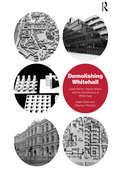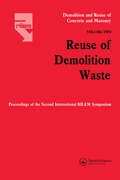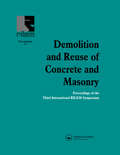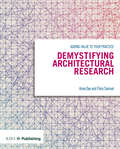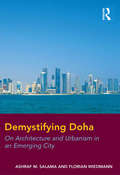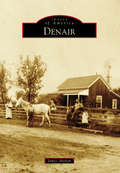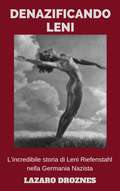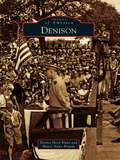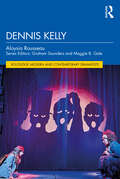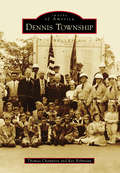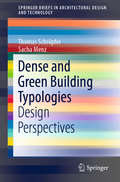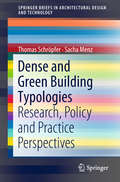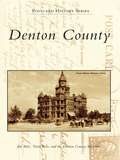- Table View
- List View
Demokratie und Soziale Arbeit: Sensibilisierung für die Wahrnehmung und Veränderung von Ungleichheiten in unserer Gesellschaft
by Monika Alamdar-Niemann Bärbel Schomers Marion TackeDer Tagungsband „Demokratie und Soziale Arbeit“ befasst sich aus unterschiedlichen Perspektiven mit zentralen aktuellen Fragen der Sozialen Arbeit. Wie kann Teilhabe und Partizipation in der Gesellschaft ungeachtet der sozialen Lage der Adressat*innen, ihres Geschlechts, ihrer sexuellen Orientierung, ihrer ethnischen Herkunft und Hautfarbe, ihrer Religion und Sprache, ihres Alters und rechtlichen Status ermöglicht werden? Soziale Arbeit mit Blick auf die zugrundeliegenden strukturellen Mechanismen von Ausgrenzung und Abwertung zielt auf eine Humanisierung der deutschen Gesellschaft. Es geht um nicht weniger als die Professionalisierung einer Arbeit gegen Diskriminierung zur Wahrung demokratischer Prinzipien, denen sich die hier versammelten Autor*innen widmen.
Demolishing Whitehall: Leslie Martin, Harold Wilson and the Architecture of White Heat
by Adam Sharr Stephen ThorntonThis book is about a lost world, albeit one less than 50 years old. It is the story of a grand plan to demolish most of Whitehall, London’s historic government district, and replace it with a ziggurat-section megastructure built in concrete. In 1965 the architect Leslie Martin submitted a proposal to Charles Pannell, Minister of Public Building and Works in Harold Wilson’s Labour government, for the wholesale reconstruction of London’s ’Government Centre’. Still reeling from war damage, its eighteenth- and nineteenth-century palaces stood as the patched-up headquarters of an imperial bureaucracy which had once dominated the globe. Martin’s plan - by no means modest in conception, scope or scale - proposed their replacement with a complex that would span the roads into Parliament Square, reframing the Houses of Parliament and Westminster Abbey. The project was not executed in the manner envisaged by Martin and his associates, although a surprising number of its proposals were implemented. But the un-built architecture is examined here for its insights into a distinctive moment in British history, when a purposeful technological future seemed not just possible but imminent, apparently sweeping away an anachronistic Edwardian establishment to be replaced with a new meritocracy forged in the ’white heat of technology’. The Whitehall plan had implications well beyond its specific site. It was imagined by its architects as a scientific investigation into ideal building forms for the future, an important development in their project to unify science and art. For the political actors, it represented a tussle between government departments, between those who believed that Britain needed to discard much of its Victorian and Edwardian decoration in the name of ’professionalization’ and those who sought to preserve its ornate finery. Demolishing Whitehall investigates these tensions between ideas of technology and history, science and art, socialism and el
Demolition Methods and Practice V1
by Y. KasaiThis book contains papers, presented at the Second International RILEM Symposium on Demolition and Reuse of Concrete and Masonry, held in Tokyo, Japan, in November 1988, on various demolition techniques and practice as well as demolition machines of concrete structures.
Demolition Reuse Conc Mason V2
by Y KasaiThis book includes papers on demolition methods and practice and reuse of demolition waste, presented at RILEM symposium held in Japan. The papers contribute to the development of demolition and reuse of concrete and masonry structures.
Demolition and Reuse of Concrete and Masonry: Proceedings of the Third International RILEM Symposium
by Erik K. LauritzenThis book forms the Proceedings of the Third International RILEM Symposium in Odense, Demark in October 1993. It includes reviews and reports of recent developments in the fields of demolition techniques and reuse of waste building materials, and focusses on the integration of demolition and recycling operations in the construction and housing indu
Demonizing the Other: Antisemitism, Racism and Xenophobia
by Robert S. WistrichAt the close of the twentieth century the stereotyping and demonization of 'others', whether on religious, nationalist, racist, or political grounds, has become a burning issue. Yet comparatively little attention has been paid to how and why we fabricate images of the 'other' as an enemy or 'demon' to be destroyed. This innovative book fills that gap through an interdisciplinary, cross-cultural approach that brings together a distinguished array of historians, anthropologists, psychologists, literary critics, and feminists.The historical sweep covers Greco-Roman Antiquity, the MIddle Ages, and the MOdern Era. Antisemitism receives special attention because of its longevity and centrality to the Holocaust, but it is analyzed here within the much broader framework of racism and xenophobia. The plurality of viewpoints expressed in this volume provide fascinating insights into what is common and what is unique to the many varieties of prejudice, stereotyping, demonization, and hatred.
Demons in the Spring: Stories
by Joe MenoDemons in the Spring is a collection of twenty short stories by Joe Meno, author of the smash hits The Boy Detective Fails and Hairstyles of the Damned, with illustrations by twenty artists from the fine art, graphic art, and comic book worlds--Todd Baxter, Kelsey Brookes, Ivan Brunetti, Charles Burns, Nick Butcher, Steph Davidson, Evan Hecox, Kim Hiorthoy, Paul Hornschemeier, Cody Hudson, Caroline Hwang, kozyndan, Geoff McFetridge, Anders Nilsen, Laura Owens, Archer Prewitt, Jon Resh, Jay Ryan, Souther Salazar, Rachell Sumpter, and Chris Uphues.Oddly modern moments which occur in the most familiar of public places, from offices to airports to schools to zoos to emergency rooms: a young girl who refuses to go anywhere unless she's dressed as a ghost; a bank robbery in Stockholm gone terribly wrong; a teacher who's become enamored with the students in his school's Model United Nations club; a couple affected by a strange malady-a miniature city which has begun to develop in the young woman's chest, these inventive stories are hilarious, heartbreaking, and unusual.Joe Meno is the best-selling author of the novels Hairstyles of the Damned, The Boy Detective Fails, How the Hula Girl Sings, and Tender As Hellfire. He was the winner of the 2003 Nelson Algren Award for short fiction and is a professor of creative writing at Columbia College Chicago.*A portion of the author's proceeds from the book will go directly to benefit 826 CHICAGO, a nonprofit tutoring center, part of the national organization of tutoring centers with branches in San Francisco, Los Angeles, New York City, and Seattle.*
Demystifying Architectural Research: Adding Value to Your Practice
by Flora Samuel Anne DyeThis practical, hands on introduction guides you through the basics of undertaking research in day-to-day architectural practice helping you to exploit the growing opportunities on offer. It explores how developing a research specialism can improve the quality of your projects, help to define your brand and generate new channels of revenue with innovative services for clients. The text is divided into four sections focussing on different types of Architecture Research Practice; commercial, cultural, social and technology. Each section includes a series of inspiring case studies written by practitioners themselves on the way in which research benefits their business as well as an essay by an expert which sets these projects in their methodological context. In this way the book highlights the broad spectrum of research being undertaken and the practical implications for the practice and their projects. This is designed for architects and practices who want to develop a clear specialism that adds brand value and will enable them to access new funding streams as well as students of architecture who are getting to grips with architectural research.
Demystifying Doha: On Architecture and Urbanism in an Emerging City
by Ashraf M. Salama Florian WiedmannOver the past decade or so, the wealth produced by Qatar's oil and gas exports has generated a construction development boom in its capital city of Doha and the surrounding vicinity. Since the late 1990s, the number of inhabitants has grown from less than 400,000 to more than 1.7 million today. In many respects, Doha is portrayed as an important emerging global capital in the Gulf region, which has been positioning and re-inventing itself on the map of international architecture and urbanism, with a global image of building clusters of glass office towers, as well as cultural and educational facilities. While focusing on the architectural and planning aspects of Doha's intensive urbanization, this first comprehensive examination of the city sets this within the socio-political and economic context of the wider Arabian Peninsula. 'Demystifying Doha - On Architecture and Urbanism in an Emerging City' features a comprehensive discussion on contemporary architecture and urbanism of Doha as an emerging regional metropolis. It provides a critical analysis of the evolution of architecture and urbanism as products of the contemporary global condition. Issues that pertain to emerging service hubs, decentralised urban governance, integrated urban development strategies, image-making practices, urban identity, the dialectic relations between the city and its society and sustainable urbanism are all examined to elucidate the urban evolution and the contemporary condition of Doha. 'Demystifying Doha - On Architecture and Urbanism in an Emerging City' concludes by suggesting a framework for future studies of the city as well as for investigating the future of similar cities, setting out an agenda for sustainable urban growth, while invigorating the multiple roles urban planners and architects can play in shaping this future.
Denair (Images of America)
by James ShehanRancher John T. Davis first established Davis Ranch in 1871, but it would be over 30 years before the land was declared the town of Denair. Tucked away in the San Joaquin Valley, this small oasis offered an abundance of fertile land and water, as well as close proximity to the expanding railroad. Originally considered the townsite of Elmwood, it was renamed Denair on April 14, 1907, for John Denair, a Santa Fe railroad man and land developer who had purchased 9,000 acres in the area. Over the next 100 years, the settlement of Denair slowly grew. Businesses came and went. Families and farms appeared and then disappeared like shifting sands, only to be replaced by others years later. In Denair, nothing ends--it just changes.
Denazificando Leni: L’incredibile storia di Leni Riefenstahl nella Germania Nazista
by Lázaro DroznesDopo la Seconda Guerra Mondiale, il Comitato di Denazificazione degli Alleati tentò di stabilire il grado di responsabilità di ogni tedesco nei crimini nazisti come parte della campagna di democratizzazione portata avanti nella Germania del dopoguerra. Questa drammatica rappresentazione ricrea il processo di Leni Riefenstahl, famosissima regista responsabile di molti documentari inneggianti al regime nazista. Numerose scene dei suoi documentari vengono usate come prova contro di lei, con la pretesa che questi siano stati strumentali come mezzi di propaganda a favore del regime. Leni difende la propria indipendenza e autonomia di artista. Nel corso del processo vengono trattati diversi problemi, come il rapporto tra l’arte e la politica, l’essere un artista indipendente dal potere politico e la possibilità di creare un’arte esclusivamente nell’interesse dell’arte.
Denim Mania: 25 Stylish Ways to Transform Your Jeans
by Carmen Webber Carmia MarshallDesigners Carmen Webber, a contestant on Season 4 of Bravo's Project Runway, and Carmia Marshall, aka Sistahs of Harlem, have created a sensation with their fabulous blend of street couture and uptown chic, as seen in the pages of many fashion magazines and on the backs of many style-conscious fashionistas.In Denim Mania Carmen and Carmia teach you to make 25 of their hottest designs, with patterns and instructions so easy you can start the project in the morning and wear it out that night. With their unique blend of vintage and couture designs you can transform your denim, both old and new, into fabulous tops, bottoms, jackets, and accessories. Their designs reflect a fusion of many influences--including the sassy street style of New York City, distant world cultures, and the rich cultural legacy of Harlem. Full-color photographs, how-to illustrations, sketches, and complete step-by-step instructions accompany each project. Denim Mania shows you how to transform basic blue jeans into sassy denim couture in no time at all--so you can make it today and wear it tonight!
Denise Scott Brown (Springer Biographies)
by Biljana ArandelovicDenise Scott Brown is best known as part of one of the most acclaimed architectural partnerships in modern architectural history, Denise Scott Brown & Robert Venturi. Together with Venturi, she ran the firm Venturi, Scott Brown & Associates (VSBA). Their architectural and urban planning designs, theories and publications caused a revolution in the world of architecture. Their most famous theoretical work, co-authored with Steven Izenour, Learning from Las Vegas, became a global phenomenon that marked the 20th century. Scott Brown & Venturi were also a married couple. However, in the traditional male-dominated architectural world, men were automatically put in leadership positions while the role of women was always underplayed, although they worked in equal partnership and made the same contribution. The role of Denise Scott Brown in joint projects, in the eyes of the public, was for decades diminished, while Venturi was brought to the forefront and celebrated as a genius. She never received due recognition for her work.This book is entirely dedicated to Denise Scott Brown and gives her the credit she deserves. It informs readers about her life, analyzes her projects in both architecture and urban planning, and offers a better understanding of her theories. The seven chapters provide a comprehensive insight into the world of legendary Denise and complete the knowledge necessary to understand her as a true and authentic diva of architecture, an innovative urban planner, theorist and passionate professor. Chapter 8 is a comprehensive conclusion that rounds off the monograph through a shorter review of numerous topics covered in the previous chapters. At the very beginning of the book is a letter that Denise wrote to the author. Her words are an authentic testimony of her life after 1967. The book is richly illustrated with a total of 274 photographs, urban planning layouts and various project illustrations.
Denison
by Mavis Anne Bryant Donna Hord HuntDenison is known as "Katy's Baby," "The Infant Wonder," and "The Gateway City to Texas." Founded in 1872 as the first Lone Star stop on the Missouri, Kansas, and Texas Railroad, the city rapidly grew to 3,000 residents in its first 100 days. Citizens of the new town wanted a quality education for their children, and in 1873 they opened the first free, graded public school in the state. From Denison came many influential people, including Allied Forces supreme commander and U.S. president Dwight David Eisenhower, born here in 1890. The Perrin Air Force Base served as an important military training facility from 1941 until the 1970s. Denison is now home to numerous industries and major providers of medical services, and the Denison Dam across the Red River has formed a major recreation area for local citizens.
Denison (Postcard History)
by Brian HanderDenison was founded in 1872, when the Missouri-Kansas-Texas (MKT) Railroad established a terminus just south of the Red River. The small town quickly grew to hold a prominent place in the 19th-century American West, and it prospered alongside the railroad, becoming the gateway to Texas from the North. Denison has the distinction of being the birthplace of Pres. Dwight Eisenhower, the site of the first free, graded public school in Texas, and home to beautiful Lake Texoma. This book features a diverse collection of postcard images and takes readers on a journey through Denison's colorful past.
Dennis Hopper: Interviews (Conversations with Filmmakers Series)
by Nick DawsonThe legendary Dennis Hopper (1936-2010) had many identities. He first broke into Hollywood as a fresh-faced young actor in the 1950s, redefined himself as a rebel director with Easy Rider in the late 1960s, and became a bad boy outcast for much of the 1970s. He returned in the 1980s with standout performances in films like Blue Velvet and Hoosiers, was one of the great blockbuster baddies of the 1990s, and ended his career as a ubiquitous actor in genre movies. Hopper, however, was much more than just an actor and director: he was also a photographer, a painter, and an art collector not to mention a longtime hedonist who kicked his addiction to drugs and alcohol and became a poster boy for sobriety. Dennis Hopper: Interviews covers every decade of his career, featuring conversations from 1957 through to 2009, and not only captures him at the significant points of his tumultuous time in Hollywood but also focuses on the lesser-known aspects of the man. In this fascinating and highly entertaining volume—the first ever collection of Hopper's interviews—he talks in depth about film, photography, art, and his battles with substance abuse and, in one instance, even takes the role of interviewer as he talks with Quentin Tarantino.
Dennis Kelly (Routledge Modern and Contemporary Dramatists)
by Aloysia RousseauDennis Kelly explores Kelly’s unusual career path and sheds light on his eclectic approach to the arts, characterised by a refusal to write texts that people can fit within neat categories. This is the first monograph on Kelly’s work for stage and screen and brings to light his essential contribution to contemporary British drama and his huge range of work including his rise to international fame with Matilda the Musical.Drawing on Kelly’s published and unpublished texts, his work in production, reviews, original interviews with directors, actors and with Kelly himself as well as critical theory, Dennis Kelly examines and reappraises key motifs in his work such as his preoccupation with violence, the complex relationship between the individual and the community or his emphasis on storytelling. It also offers new insights into overlooked aspects of Kelly’s work by setting out to explore his traumatic narratives and his post-romanticism. In keeping with Kelly’s wish never to repeat himself, this study offers multiple critical entries into his plays, television series and films, drawing on moral and political philosophy, trauma studies, studies in humour, feminist theory and film studies.Part of the Routledge Modern and Contemporary Dramatist series, Dennis Kelly is addressed to students and scholars in Drama, Theatre and Performance as well as theatre practitioners and offers in-depth analysis of one of the most unique and challenging voices in contemporary British playwriting and screenwriting.
Dennis Township (Images of America)
by Thomas Champion Ray RebmannDennis Township is more than a swampy, desolate locale tourists drive through to reach the beach at the Jersey Shore. It is actually eight unique communities, stretching from the Garden State Parkway to the east to Delaware Bay and Cumberland County to the west. Dennis is farmland and forests of oak and pine. Meadows teem with wildlife, all just minutes away from busy beaches. Dennis Township is also about people, many of whom trace their roots back to before the American Revolution. It has a population of determined individualists, mixed with just enough "new blood" to sustain a vibrant community. Geography and people invigorate the township's eight hamlets, including Dennisville, Belleplain, and South Seaville, which were formerly independent towns but are now more regarded as signposts along the traveler's way. People have lived there for generations and will be living there still long after the tourists have moved on. This books tells more than one story, but all of the stories equally make Dennis Township the special place it long has been.
Dense and Green Building Typologies: Design Perspectives (SpringerBriefs in Architectural Design and Technology)
by Thomas Schröpfer Sacha MenzIn this book, leading architects and landscape architects provide their perspectives on the design of dense and green building types in high-density urban contexts that can support higher population densities, higher standards of environmental sustainability and enhanced liveability in future cities.
Dense and Green Building Typologies: Research, Policy and Practice Perspectives (SpringerBriefs in Architectural Design and Technology)
by Thomas Schröpfer Sacha MenzIn this book, academics, policy makers, developers, architects and landscape architects provide a systematic review of the environmental, social, economic and design benefits of dense and green building types in high-density urban contexts and discuss how these can support higher population densities, higher standards of environmental sustainability and enhanced live ability in future cities.
Densho Origami: Traditional Japanese Figures for Everyone
by Kodansha InternationalDensho origami is based on figures from Japanese folklore, handed down from generation to generation for over a hundred years. These densho origami figures are all quite simple to make, but beautiful and balanced, and are considered an expression of Japan's heart, soul, wisdom, and culture.Densho Origami introduces thirty-five of the most classic, beloved origami figures—the crane, the samurai helmet, the ninja star, the goldfish, etc. The instructions are extremely easy to follow and rely on over 500 3-D, computer-generated diagrams which guide the reader through each step.With its clean design, careful instructions, and highly-detailed diagrams, Densho Origami is the perfect first book for both children and adults who want to explore this charming, creative, and rewarding art. It's also an ideal way for adults to share origami with children, continuing the long tradition of passing on to the next generation, a love and appreciation for what's come before.
Dental Image Analysis for Disease Diagnosis
by Kavindra R. Jain N. C. ChauhanThis book provides an overview of computational approaches to medical image examination and analysis in oral radiology, utilizing dental radiograph to detect and diagnose dental caries in cases of decayed teeth. Coverage includes basic image processing techniques; approaches for Region of Interest extraction and analysis; and the role of computational clustering techniques for segmentation of teeth and dental caries. The book also presents a novel multiphase level set method for automatic segmentation of dental radiographs.
Denton County
by Tricia Bolz Jim Bolz Denton County MuseumsThe history of Denton County, founded in 1846, has been well preserved through postcards. These images, produced from vintage photographs and artist renditions, reflect a time when communication through postcards was quicker, easier, and less expensive than writing a letter. Inside this book, readers are treated to charming snapshots of local history depicting churches, the downtown public square, businesses, public schools, the two newly created universities, railroad depots, trolleys, the earliest automobiles, and some of Denton County's most familiar town views and tourist attractions.
Denver Food: A Culinary Evolution (American Palate)
by Simone Fm SpinnerAllured by the gold rush, waves of German, Japanese, Chinese and Italian immigrants brought their culinary proclivities to the American West. The early sophistication of saloons followed, and Denver's gastronomic landscape experienced a tremendous culinary evolution spanning sixteen decades. Dating back to the late 1800s, My Brother's Bar doesn't have a sign and doesn't need one, serving up history along with delicious hamburgers. Established in 1985, nonprofit Denver Urban Gardens operates more than 155 community gardens across the metropolitan region. Ahead of the curve, Chef Ryan Leinonen set the city on fire with the New Nordic trend more than a decade ago when he opened Trillium Restaurant. With these stories and more, author Simone FM Spinner follows the journey from dreams of gold to fine dining, and Denver has never been more delicious.
Denver's City Park and Whittier Neighborhoods (Images of America)
by Shawn M. SnowDenver was barely 10 years old in 1868 when visionary pioneers such as Alfred B. Case and Jacob W. Downing began amassing real estate holdings far from downtown, speculation that paid off when the newly arrived railroad led to a population explosion. With the opening of the Whittier School in 1883--the largest elementary school in the city--a domain for prairie dogs evolved into a middle-class haven of fine Victorian homes. Buffalo Bill Cody's sister even called the Whittier neighborhood home. The convenience and reliability of an expanding streetcar system brought the lifeblood of the city into the neighborhood. Whittier and its residents were also blessed with the establishment of a large, 320-acre park just to the east. This park, transformed from native prairie to irrigated forest, became one of the biggest attractions in Denver--City Park.

